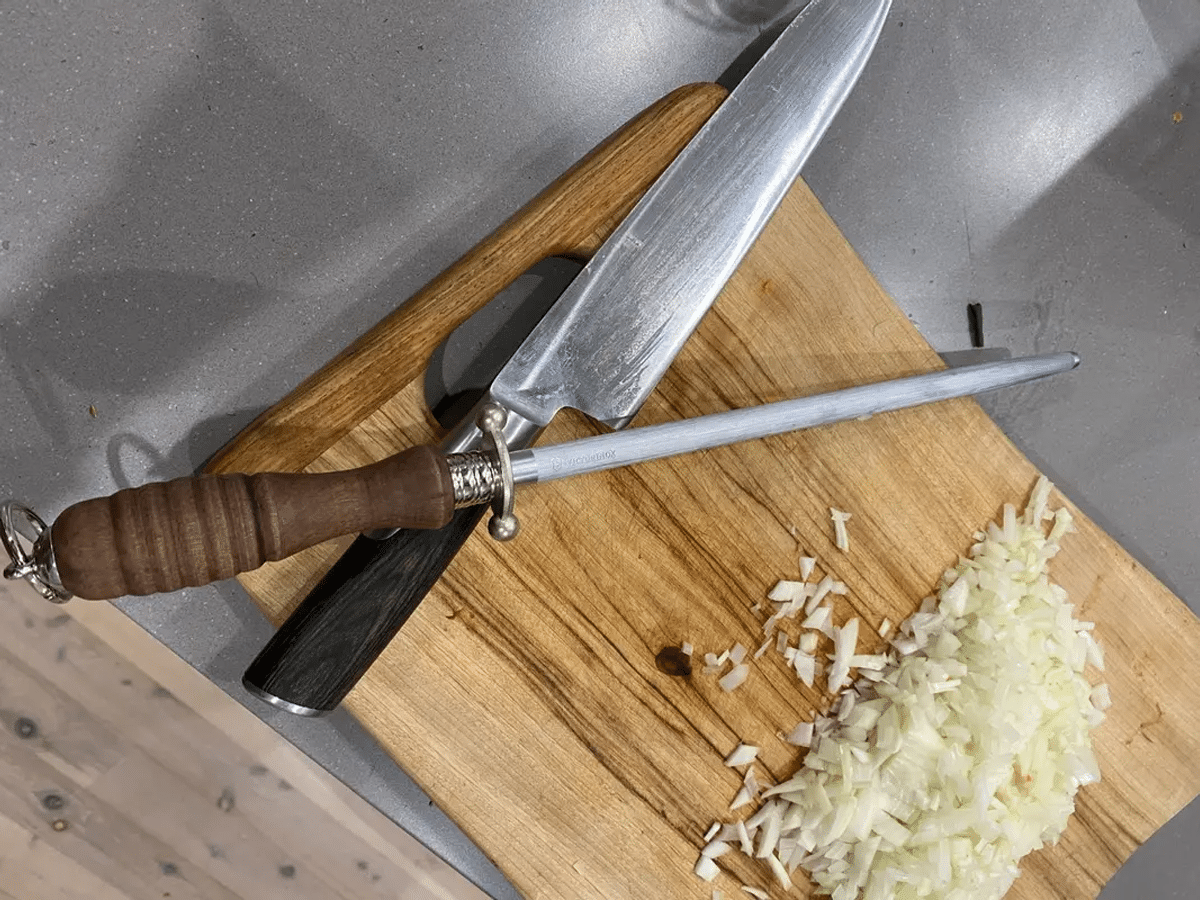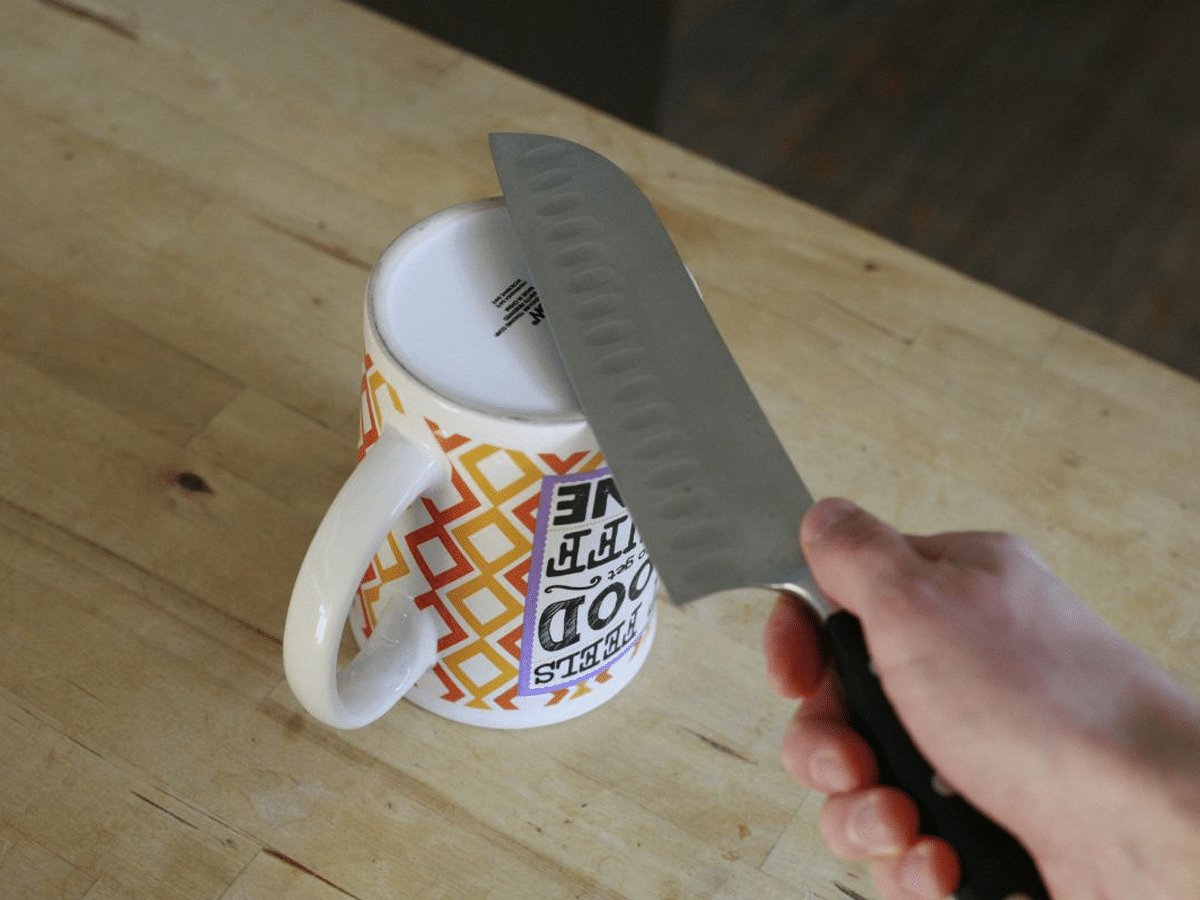
Published:
Readtime: 8 min
Every product is carefully selected by our editors and experts. If you buy from a link, we may earn a commission. Learn more. For more information on how we test products, click here.
There’s a number of different ways to sharpen a knife, you can even use a coffee mug if you’re desperate (more on that later). As always, safety comes first with knife sharpening, so if you have the funds we recommend hitting up your local knife sharpener to get the job done for you. Paying a professional is always going to be the first and best option, however, if you’re like us, you want to learn things, because lord knows impressing your partner is always cooler than paying someone. Let us explain the options before you.

How to Sharpen a Knife Using a Whetstone
Whetstones are stones used for sharpening knives. They come in a range of sizes, shapes, prices and materials. Because some knives need more sharpening than others, whetstones are commonly broken down by levels of grit and coarseness. Rough whetstones have less grit and more coarseness. As such, they’re best used for blades that are especially dull or even chipped. Medium whetstones are the most common type, and they’re used during the first step of knife sharpening (grit count from 800 to 2000). Finishing whetstones have the highest grit count (3000 or more), and they eliminate the bumps or ridges that remain after sharpening.
The more expensive the whetstone, the harder (and longer-lasting) that stone will be. Look for a $60-$70 USD price tag and you’re on the right path. There are also double-sided sharpening whetstones, which have a medium whetstone on one side and a finishing stone on the other. These are great for both beginners and those sharpening at home. Again, a quality example will generally fall in the $70 USD range.
Tools
- Quality chef’s knife
- Sharpening Whetstone.
- Sharpening stone base for mounting the whetstone
- Sharpening stone fixer for smoothing the whetstone
- Dressing stone (also known as a nagura) to erase streaks from your whetstone or create a polishing slurry for your finishing stone.
Note: A good, working whetstone retains a flat surface. Naturally, the more you use the whetstone the more the surface gets compromised. That’s why it’s important to use your sharpening stone fixer to resurface or flatten the whetstone, keeping it smooth and even. Then we can get stuck into sharpening.
Instructions
- Lubricate your whetstone.
Soak rough and medium whetstones in water for 20-30 minutes before using them.
Don’t soak the finishing stone. Instead, rinse the surface of a fine-grit stone and rub the dressing stone along that surface to create a type of polishing mud or slurry. Use the slurry on the finishing stone. - Mount the whetstone.
Place the sharpening base on a flat surface and the whetstone on top of the base.
You only need a rough (low-grit) stone if the blade is really dull. Otherwise, a medium whetstone will suffice. - Hold the knife with the edge facing up.
To hold the knife, place your thumb on the spine, and index finger on the heel and the edge facing upward.
The blade should be lined up with your arm. - Place the bevel of the edge against the whetstone at an angle.
For any given blade, there will be an adjustment period where you find the optimal angle (around 22°). - Properly position your free hand.
Put the index and middle finger of your free hand atop (not at) the tip of the blade. - Apply pressure and swipe.
Swipe the blade along the whetstone as if pulling the blade toward you. - Release pressure and repeat.
Release pressure and slide the blade back to the starting point.
Then apply pressure and swipe the blade back toward you. - Continue swiping.
Remember, only apply pressure when swiping down, repeat the motion.
Do not apply pressure when swiping upward or else you’ll damage the stone.
Maintain a consistent speed. With each swipe, crawl the index and middle finger down the blade toward the heel. - Join forces at the heel.
When the middle and index finger of your one hand reach the heel, they should meet the other index finger. - Stop and feel the opposite edge of the knife.
Using your finger, touch along the edge of the blade. You should feel a minor ridge. - Flip the knife.
Turn the knife over. The edge is now facing downward. - Re-position your fingers.
This time, the hand that’s holding the knife should have the index finger on the spine and the thumb at the heel. - Redistribute pressure when swiping.
Since the edge is now facing down, you should apply pressure when swiping away from you, not toward you.
Enact the same amount of swipes as you did on the first side. - Feel the side of the blade.
You should once again feel for bumps, aka the burr. - Use a finishing stone to polish off the burr.
You’ll know you’re done polishing when the burr has been removed from the blade’s edge.
To confirm, pinch the edge of the blade and pull away to feel for bumps. - Test the edge by slicing something.
If the blade can slice through a tomato without rumpling the skin, or a sheet of regular white paper without getting stuck, then it’s been properly sharpened. - Air-dry the stones.
You can either leave your rough/medium whetstones in water for later use, or air dry them before putting them away. Finishing stones, however, must be air-dried after use, otherwise, they’ll crack.

How to Sharpen a Knife Using a Honing Rod
The chances are you’ve either seen someone using a honing rod to “sharpen” a knife or you have one sitting in your knife draw at home. A common misconception, the honing rod doesn’t actually sharpen your knife, instead, it straightens out the sharp ‘cutting’ edge on the blade to allow for tighter, more effective and thus safer cuts. In an ideal world, you’ll have both a knife sharpener and a honing rod.
Tools
- Quality knives
- Honing Rod
Instructions
- Gripping the honing rod in your non-dominant hand, point the rod away from your body at any angle. Make sure the tip of the rod is positioned above the rod handle.
- Hold the knife in your dominant hand.
Keep four fingers on the knife handle and your thumb on the spine, away from the blade’s edge. - Place the knife at approximately a 20° angle on the holding rod.
You should make sure you maintain the same exact angle throughout the entire process. - Slide the knife across the top half of the honing rod, moving from heel to tip.
Remember, you want to maintain the same angle the whole time.
Start at the heel of the blade and swipe toward the top of the blade. - Keeping the same angle, sweep the knife across the bottom half of the honing rod.
Do the same motion as you did at the top half. This completes one revolution. - Perform 6-8 revolutions per knife.

How to Sharpen a Knife Using a Coffee Mug
Quick and easy (though probably not recommended by experts) is the method of sharpening a knife using the surprisingly rugged ceramic of an overturned coffee mug.
Tools
- Quality knives
- Coffee mug (ceramic)
Instructions
- Turn the mug upside down so that the bottom is facing upward.
- Keeping approximately a 22° angle, and moving heel to tip, swipe one side of the blade across the mug’s ceramic grit. Perform this motion several times.
- Flip the knife and perform the same process on the other side. Remember to maintain the 20° angle.
- Switch sides of the blade per swipe only for the last two to three swipes.
- Use a honing rod to smooth out any remaining kinks, burrs, or abrasions.
General FAQ
You should sharpen your knife every few months, or at the bare minimum once a year. As always, that depends on how much you use it, and how quickly you notice it dulling (honing doesn’t really improve).
Hone your knife weekly. You can even hone a knife every time you use it if you’d like your knife to remain as sharp as possible!
No, honing a knife to sharpen it is a common misconception. Honing merely straightens the edge of the cutting blade for a safer cut.
You’ll also like:
How to Make Whipped Coffee: The Viral TikTok Recipe
20 Best High Protein Breakfasts for Muscle Growth
20 Best Mexican Restaurants in Sydney: Authentic to Tex-Mex































Comments
We love hearing from you. or to leave a comment.